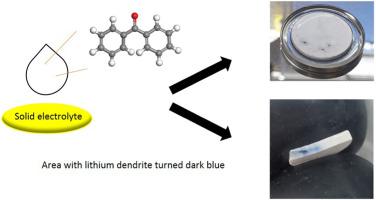Journal of Power Sources ( IF 8.1 ) Pub Date : 2021-02-20 , DOI: 10.1016/j.jpowsour.2021.229661 Haitian Zhang , Hui Wu , Li Wang , Hong Xu , Xiangming He

|
Solid-state electrolytes are regarded as the “key” materials for enabling the usage of lithium metal in high energy density lithium battery systems. However, recent reports suggest lithium dendrites still exist in solid-state electrolytes after cycling. Moreover, due to the low concentration of lithium dendrite inside solid-state electrolyte and the unique characteristic of lithium, conventional methods such as EDS (Energy Dispersive X-Ray Spectroscopy) cannot detect lithium. Analyzing lithium dendrite in solid-state electrolyte usually requires complicated and expensive equipment such as neutron diffraction, which brings extra barrier to explore the mechanism of growth of lithium dendrite in the solid-state electrolyte and exploring the solution to this problem. In this work, we report a simple and effective method to visualize the existence of lithium metal inside solid-state electrolytes in very early stage. This method may benefit the exploration of the growth mechanism of lithium dendrite inside solid-state electrolytes and solving this problem eventually.
中文翻译:

二苯甲酮作为检测固态电解质内部锂金属的指示剂
固态电解质被认为是在高能量密度锂电池系统中使用锂金属的“关键”材料。然而,最近的报道表明,锂枝晶在循环后仍存在于固态电解质中。此外,由于固态电解质中锂树枝状晶体的浓度低以及锂的独特特性,诸如EDS(能量分散X射线能谱)之类的常规方法无法检测到锂。分析固态电解质中的树枝状锂通常需要复杂且昂贵的设备,例如中子衍射,这给探索固态电解质中树枝状锂的生长机理以及解决该问题的方法带来了额外的障碍。在这项工作中,我们报告了一种简单有效的方法,可以在早期阶段可视化固态电解质中锂金属的存在。该方法可能有助于探索固态电解质中锂枝晶的生长机理,并最终解决该问题。











































 京公网安备 11010802027423号
京公网安备 11010802027423号